|
1.
CENTRAL AND WEST AFRICA
Gabon: National Dialogue Initiative
President Oligui initiated a month-long national dialogue
starting 3 April aiming for comprehensive national
reconciliation and planning for Gabon's future. All sectors,
including government departments, judiciary, ministries,
NGOs, political parties and citizen representatives are
participating. The outcome will be reported when
information becomes available.
Since the takeover in August 2023 there have been notable
adjustments within the forestry ministry aimed at
improving operational efficiency. Strict instructions have
been issued across all levels of the ministry reflecting a
concerted effort to streamline processes and ensure
compliance with regulations. However, it became apparent
to the government that certain rules were overly stringent,
leading to disruptions in timber operations, particularly
those concerning labour regulations for expatriates.
In response to these challenges the government has taken
steps to soften its stance on regulations, recognising the
need to strike a balance between regulatory compliance
and facilitating a conducive environment for timber
industry operators. This adjustment in policy has resulted
in a more favorable landscape for operators, the local
economy and the labour force. Estimates suggest that there
is now an allowance of approximately 20 to 25% for
expatriates, signalling a more flexible approach to labour
regulations within the industry.
Transaction costs rise risking competiveness
The Finance Ministry in Gabon has announced an increase
in export duties and port charges. Port charges have seen
an increase of nearly 10 Euros per cubic metre, while
export duties have risen by about 8 Euros per cubic metre.
Timber companies have protested these increases which,
they say, are not easy to pass on to customers as
competitiveness would be undermined.
An unresolved land tax issue has seen payment deadlines
extended from March 25 to April 28.
Gabon production in 2023
According to the Gabon Ministry of Economy, in the
fourth quarter of 2023 activity in the timber sector
increased by 7% quarter-on-quarter. This recovery comes
after the very strong slowdown observed in the third
quarter says a Lenouveau Gabon news item.
The recovery was particularly noticeable in the sawmilling
and veneer sectors says Lenouveau Gabon. Sawmill
production had increased by 14% at the end of the fourth
quarter of 2023. However, for the full year, production
declined by 13%, mainly because of weak demand.
Veneer production recovered by 3% at the end of the
fourth quarter of 2023. Over the 12 months of 2023
veneer production improved slightly (1%) despite the drop
in demand in Asia and Europe and because of competition
from poplar veneer.
An improvement was not observed in plywood sector as in
the fourth quarter activity dropped 7% compared to the
third quarter of 2023. This poor performance was put
down mainly to the real estate crisis in China.
Rains affecting harvesting in Gabon and Congo but
not Cameroon
Gabon is experiencing the full force of the rain season
which is affecting up-country operations. Veneer and
plywood mills can continue production but some report
declining log stocks, particularly for okoume. Sawmill-
grade logs are also said to be in short supply at a time
when there has been an upturn in demand in Asian
markets.
China, in particular, is showing interest in a variety of
timber species including Bilinga, Ayous, Okan, Movingui,
and Sapelli, alongside the traditional demand for Okoume.
Additionally, there is steady demand from the Philippines.
Heavy rains are affecting harvesting activities in Northern
Congo. Transporting timber to Douala Port which is closer
than Pointe Noire in the South presents a logistical
challenge with a distance of about 1400km. In the
southern regions heavy rains are prevalent.
Despite the challenges, harvesting of okoume has resumed
as there has been an increase in orders from China.
However, Ovangkol is no longer in demand while other
species, such as padouk, bilinga, movingui and sapelli are
sought after.
In contrast to those countries experiencing rain, Cameroon
is currently experiencing a dry period which should last
until June allowing unrestricted harvesting. Millers report
stocks have returned to normal levels with approximately
two months required in readiness for the upcoming rain
season.
Trucking operations have returned to normal levels,
indicating improved conditions for transporting timber
from forests to mills and log depots. Both road and railway
networks are functioning effectively, contributing to the
efficient movement of timber resources.
Producers in Cameroon report growing interest in China
for bilinga, padouk, iroko, movingui and sapelli all of
which are available in Cameroon.
At Douala Port operations remain steady with no
disruptions reported. Logs originating from Northern
Congo and the Central African Republic continue to be
shipped smoothly. Efforts to improve port operations have
been reported following the management transition from
Bollore to MSC and this is said to be contributing to more
efficient shipments.
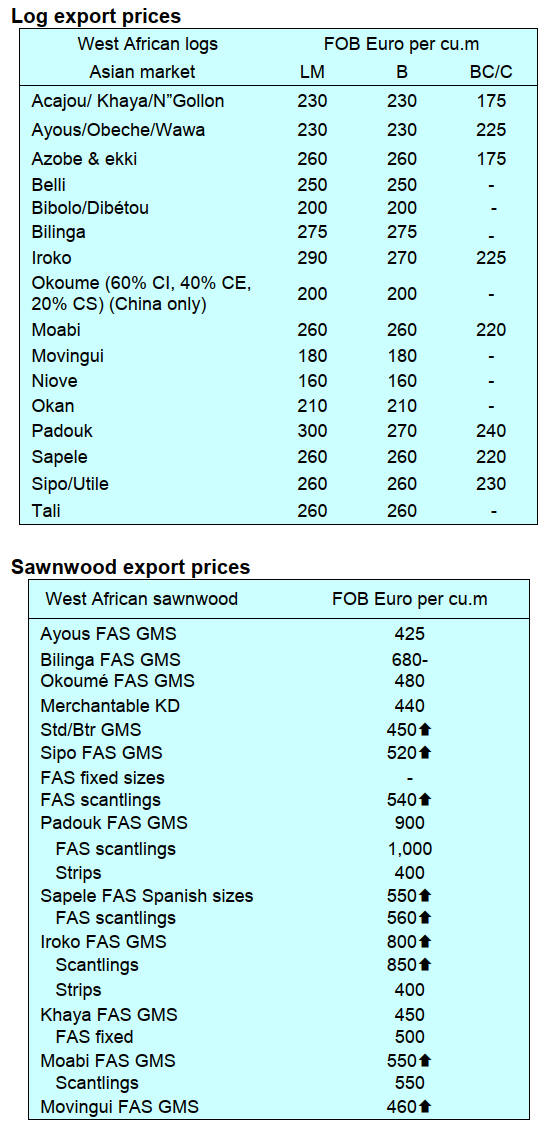
2.
GHANA
2023 export volumes less than 2021 and 2022
Data from the Statistics and Research Unit of the Timber
Industry Development Division (TIDD) of the Forestry
Commission (FC) show that Ghana’s wood product
exports for FY2023, at 293,000 cu.m, were lower than the
volumes recorded for either 2021 or 2022.
The total export volume shipped in 2023 was the lowest
compared to each of the two previous years and 2023
export volumes were the second lowest over the past 10
years (2014 to 2023) and the fourth lowest during the
period 2010 to 2023.
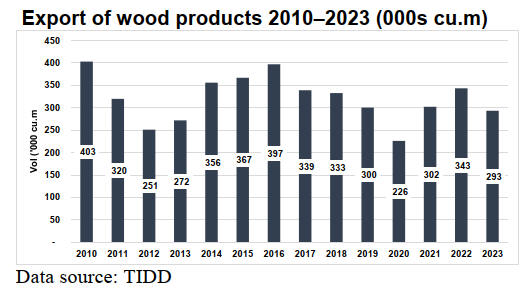
The country’s highest export volume was 403,000 cu.m
achieved in 2010 and the lowest was 226,000 cu.m
recorded in 2020 put down to the impact of COVID-19.
Air-dried sawnwood accounted for 46% of 2023 exports
while plywood to the regional market was 16% and kiln-
dried sawnwood also 16% which together accounted for
78% of the total export volume between 2010 and 2023
(4,503,896 cu.m), shown in table below;
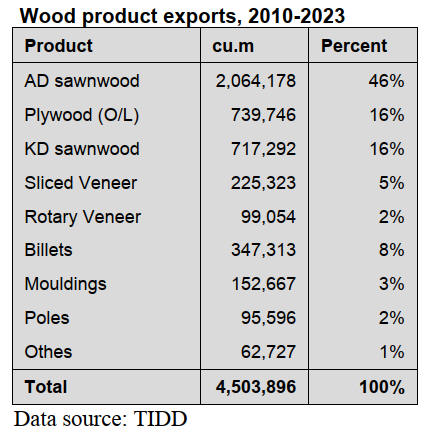
Teak logs (Billets) were the leading wood product export
in 2023. The export of teak logs increased from 497 cu.m
in 2022 to 8,691 cu.m in 2023 while the value increased
from Eur 0.17 million in 2022 to Eur2.82 million in 2023.
President assents to Wildlife Management Resources
Bill
President Nana Addo Dankwa Akufo-Addo has assented
into law the Wildlife Management Resources Bill. The
Bill, which had been pending for over fifteen (15) years,
had previously laid before the fifth, sixth and seventh
Parliaments until it was eventually passed by the Eighth
Parliament in 2022.
The Wildlife Resources Management Act, (Act 1115),
sponsored by the Ministry of Lands and Natural Resources
(MLNR), seeks to revise and consolidate all laws relating
to wildlife and protected areas and bring it in conformity
with existing policies and emerging trends in the natural
resources sector. It also ensures the effective
implementation of international conventions on wildlife to
which Ghana is a signatory.
Additionally, the new legislation gives legal backing to
local communities in wildlife management through the
creation of Community Resource Management Areas
(CREMAs) and introduces higher penalties and sanctions
for wildlife offences.
See:
https://www.graphic.com.gh/news/general-news/ghana-news-president-signs-wildlife-bill-into-law.html
COP 28 Secretariat delegation visits Forestry
Commission
A delegation from the Twenty-Eight Conference of Parties
(COP 28) Secretariat paid a working visit to the Forestry
Commission office in Accra.
The visit was a follow-up to the COP28 held in Dubai in
December 2023 where Ghana unveiled its ‘Resilient
Ghana’ country package which is vehicle of the Forest and
Climate Leaders’ Partnership. At the launch, the United
Arab Emirates (UAE) announced a bilateral partnership to
support the implementation of Ghana’s package.
The purpose of the delegation’s visit was to explore
priority areas to support in climate and nature action.
In her address at the FC HQ, the Director of the Climate
Change Department, Ms. Roselyn Fosuah Adjei, expressed
her enthusiasm for the partnership with the UAE on the
‘Resilient Ghana’ Project. She expressed her hopes for a
strong and fruitful partnership between the two countries.
See:
https://fcghana.org/fc-receives-cop-28-secretariat-delegation/
Inflation a deterrent to industrial and economic growth
Inflation in March 2024 shot up to 26% from 23%
recorded in February 2024 according to the Ghana
Statistical Service (GSS). Ghana’s inflation has been a
deterrent to both industrial and economic growth.
Industries and businesses continue to face high operational
costs due to the high cost of electricity and fuel among
others.
The Association of Ghana Industries (AGI) has described
the cost of doing business in Ghana as still high compared
to other countries in the West African sub-region. It has
made several appeals to the government to work with the
Bank of Ghana to reduce inflation and interest rates for
local businesses to thrive.
There will be new taxes taking effect this year as part of
the government’s revenue mobilisation measures with the
IMF which could have a negative impact on the
profitability of many businesses.
According to the Ghana News Agency, the continual
power outages in the country are reportedly due to a
generation shortfall which is largely attributed to
inadequate gas supply maintenance and faulty production
plants.
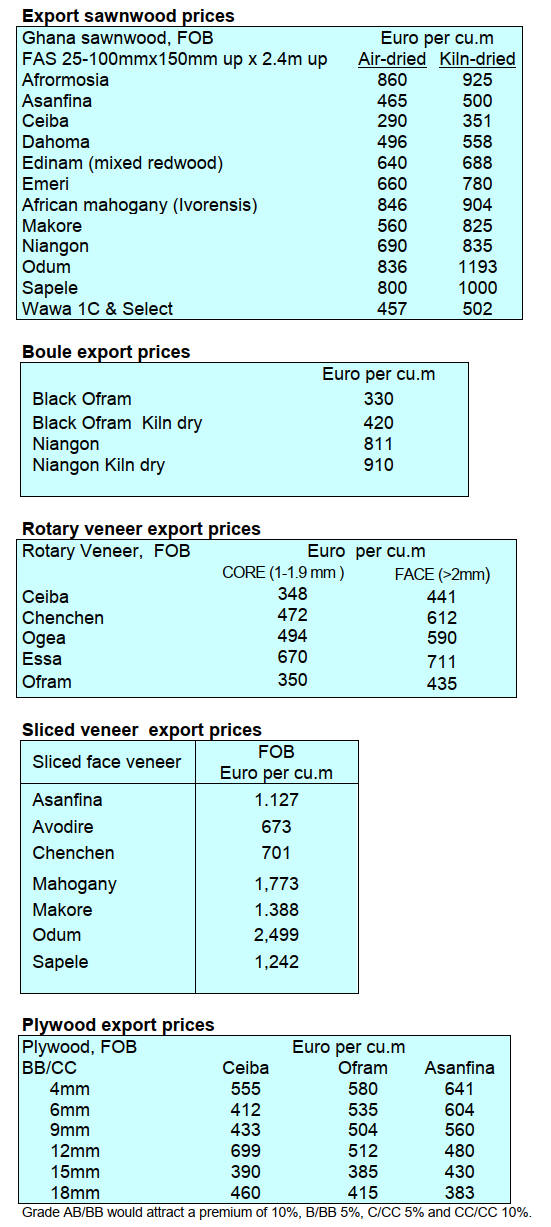
3. MALAYSIA
Solid growth forecast
The World Bank, in its East Asia and Pacific April 2024
Economic Update, maintained its forecast for Malaysia’s
economy to grow 4.3% this year as household spending
accelerates amid moderate inflation. This forecast is in line
with Malaysia's own projection of growth of between 4%
and 5% in 2024, versus a 3.7% expansion in 2023.
See:
https://ceomorningbrief.theedgemalaysia.com/2024/0742/
Raw material shortages must be addressed - MPMA
Raw material shortages present a significant obstacle for
the country's timber industry, particularly the downstream
sector, according to the chairman of the Malaysian Panel-
Products Manufacturers' Association (MPMA), Sheikh
Othman Rahman. He added, Malaysia has the potential to
produce high-value wood products but efforts are needed
to address raw material supplies.
He said the scarcity of raw materials is hindering
production and affecting key products such as plywood,
medium-density fibreboard and particleboard. Plywood is
ranked as the second largest wood exported, after wooden
furniture.
The plywood industry has been looking into alternative
raw materials such as oil palm trunks, coconut trunks and
rubberwood, among others, to ensure sufficient supply. In
2019, the MPMA signed a Memorandum of
Understanding with Forest Research Institute Malaysia
(FRIM) and Plus Intervest for collaboration on producing
tissue culture eucalyptus seedlings. Eucalyptus is known
for having good potential for plywood production and
presents a promising solution to the industry's raw material
scarcity issues.
See:
https://www.nst.com.my/news/nation/2024/03/1031436/exploring-new-raw-material-sources-timber-industry
Adapt businesses to the green economy, adopt
advanced technologies
The timber industry in Sarawak is advised to adjust their
business models focusing on the green economy and high
technology within the framework of the Fourth Industrial
Revolution (IR 4.0).
The Deputy Prime Minister, Awang Tengah Ali Hasan,
said, like all other industry players, the timber industry
needs to look at new ways for their businesses to be more
competitive while being in line with the Post-Covid
Development Strategy 2030 which focuses on the green
economy.
He said, for example, the bioenergy industry has great
potential to be explored as there is a growing demand for
wood pellets in Japan, South Korea and France.
At the same time,he suggested that State timber industry
players adapt to IR 4.0 technologies as this emphasises the
use of automation and digital technology which enables
the industry to be more competitive both at home and
overseas.
See:
http://theborneopost.pressreader.com/article/281745569393286
Struggling with labour shortages
The Sarawak Timber Association (STA) has called on the
government to establish more consistent policies and
streamlined processes for the recruitment of foreign
workers.
Its chairman, Henry Lau, said this was in light of the
challenges faced by the timber industry which continues to
grapple with persistent labour shortages, particularly in the
forest plantation and oil palm sectors.
“A more predictable and efficient framework will not only
help mitigate the current labour shortage but also
contribute to the long-term stability of the timber
industry.” Lau is quoted as saying.
He commended the Sarawak government’s recent
initiative on exploring the establishment of processing
mills within the industrial forests. STA firmly believes that
this initiative holds great promise for reducing log costs
which are currently high due to long distance
transportation.
See:
https://www.pressreader.com/malaysia/the-borneo-post-sabah/20240327/281754159323245
Malaysia's largest port to double capacity
Malaysia's largest port, Port Klang plans to double its
capacity. Port Klang, the world's 12th-largest port and
second only to Singapore in Southeast Asia in terms of
capacity plans to increase its annual capacity from 14
million TEUs to 27 million TEUs.
The expansion will take over 40 years according to Ruben
Emir Gnanalingam, the Executive Chairman and group
Managing Director of Westports.
See:
https://www.straitstimes.com/asia/se-asia/malaysia-plans-84-billion-port-to-keep-up-with-regional-competitors
4.
INDONESIA
Export Benchmark Price (HPE) of wood
products, March
2024
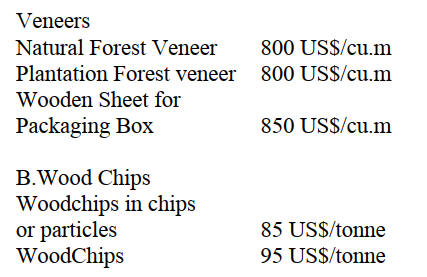
Processed Wood
Processed wood products which are leveled on all four
sides so that the surface becomes even and smooth with
the provisions of a cross-sectional area of 1,000 sqmm to
4,000 sqmm (ex 4407.11.00 to ex 4407.99.90)
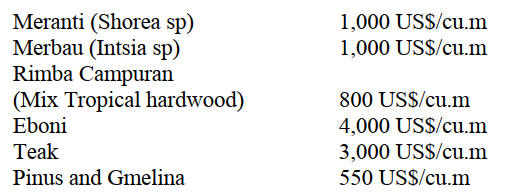
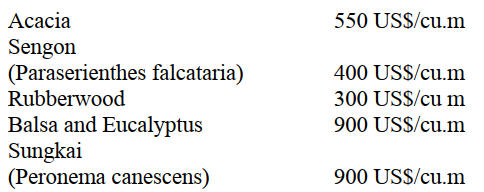
Processed wood products which are leveled on all
four
sides so that the surface becomes even and smooth with
the provisions of a cross-sectional area of 4,000 sqmm to
10,000 sqmm (ex 4407.11.00 to ex 4407.99.90)

Processed wood products which are leveled on all
four
sides so that the surface becomes even and smooth with
the provisions of a cross-sectional area of 10,000 sqmm to
15,000 sqmm (ex 4407.11.00 to ex 4407.99.90)

See:
https://jdih.kemendag.go.id/pdf/Regulasi/2024/Kepmendag%20Nomor%20415%20Tahun%202024.pdf
Forest product exports showing improvement
Indonesia’s forest product exports have shown
improvement in early 2024 despite market uncertainties
according to the Ministry of Environment and Forestry
Ministry (KLHK).
Data from the Ministry shows Indonesia’s forest product
exports reached US$3.5 billion in the first three months of
2024 with pulp products contributing US$798.05 million,
paper US$1.1 billion and wooden panels US$582.7
million. Compared with the same period of last year
exports grew 8% as of March, a rebound after remaining
in negative territory for most of 2023.
See:https://en.antaranews.com/news/310293/forest-product-exports-improving-forestry-ministry
and
https://en.tempo.co/read/1854321/indonesian-forestry-ministry-says-forest-product-exports-improving
Data on forest cover readied for EUDR
In order to be ready for the EUDR Indonesia is making
available complete data on forest cover generated by the
‘Simontana’ or the National Forest Monitoring System,
said the KLHK Minister, Siti Nurbaya Bakar. The EU
published European Union Forest Observatory (EUFO)
data in December 2023 and plans to release the final
version of the EUFO map in December 2024.
The Minister said "From now on until the end of this year
it is important to correct the EUFO map so that Indonesia's
country risk assessment claim can be in the low category
and the origin of commodities will not be included in the
category of deforestation and land degradation areas".
During a focus group ‘Deepening Sectoral Legality and
Sustainability in Forest Areas in the Context of a
Deforestation-Free Supply Chain’ the Minister
emphasised the importance of utilising accurate data on
Indonesian forests to deal with deforestation issues at the
global level. She said the Ministry had corrected
deforestation data released by the World Resources
Institute (WRI) and the institution eventually understood
Indonesia's success in reducing the rate of deforestation.
See:
https://en.antaranews.com/amp/news/310155/indonesia-to-present-data-on-forest-coverage-to-deal-with-eudr
and
https://forestinsights.id/indonesia-ready-to-present-forest-data-in-response-to-eudr/
Encouraging intensification of natural forest
enrichment
The Association of Indonesian Forest Concession Holders
(APHI) is encouraging the intensification of enrichment in
low productivity natural forests to be accompanied by a
pause in harvesting.
Purwadi Soeprihanto, Secretary General of APHI, has
stated that production from natural forest areas managed
under Forest Utilisation Business Permits (PBPH) has
remained stagnant at approximately 4-6 million cubic
metres per year. Meanwhile, there has been a rapid
increase in plantation timber production.
In 2015, wood production from plantation forests was
33.22 million cubic metres and production has continued
to increase yearly and reached 52.8 million cubic metres in
2023.
Purwadi said that, with the decline in the productivity of
natural forests and an increase in production from
plantation forests, it is necessary to restructure the
governance of natural forests. He suggested in areas where
the productivity is below 30 cubic metres per hectare there
should be intensive enrichment and a pause in logging.
See:
https://forestinsights.id/aphi-dorong-intensifikasi-pengayaan-hutan-alam/
Five company directors sentenced for illegal logging
The Ministry of Environment and Forestry has praised the
ruling of the East Java's Surabaya District Court that
imposed imprisonment and fines of billions of rupiah on
five company' directors for illegal logging in Papua. In a
statement from the Directorate General of Law
Enforcement (Gakkum) of the KLHK, Director General
Rasio Ridho Sani, expressed hope that the prison
sentences and fines would provide a deterrent.
See:
https://en.antaranews.com/news/309204/klhk-lauds-verdict-for-5-companies-over-illegal-logging-distribution
Importance of local wisdom in forest management
A National Research and Innovation Agency (BRIN)
researcher, Binov Handitya, highlighted the importance of
local wisdom as a consideration in forest governance,
especially for communities that have lived a long time
around forests.
During an online discussion Handitya stated that the
relationship between forest protection and local wisdom
can be found in the lives and behavior of indigenous
people who have lived for centuries around the forest.
"Local communities have their own way of taking care of
the land and natural resources because they have a
spiritual attachment to the forest” he remarked. Ancestral
values and ethics included in local wisdom encompass
how humans should treat nature and relate to nature that
has existed for a long time. "Local communities can be a
major agent in terms of biodiversity protection and forest
conservation," he noted.
See:
https://esgnow.republika.co.id/berita/sb1bt6457/peneliti-soroti-pentingnya-kearifan-lokal-dalam-tata-kelola-hutan#google_vignette
Abundant wood biomass in Indonesia
The government supports the use of wood-based biomass
in its energy transition plan as this will create new job
opportunities by involving communities in raw material
procurement. According to Nani Hendiarti, Deputy for
Environmental and Forestry Management Coordination at
the Coordinating Ministry for Maritime Affairs and
Investment, the Ministry has responsibilities in
coordination and realising national wood-based biomass
energy production.
In related news, the Coordinating Ministry for Maritime
Affairs and Fisheries has been involved in pushing for
approval for biomass fuel as a co-firing in electric steam
power plants (PLTUs).
See:
https://www.liputan6.com/bisnis/read/5558864/melimpah-di-indonesia-biomassa-kayu-jadi-solusi-tekan-emisi-karbon?page=2
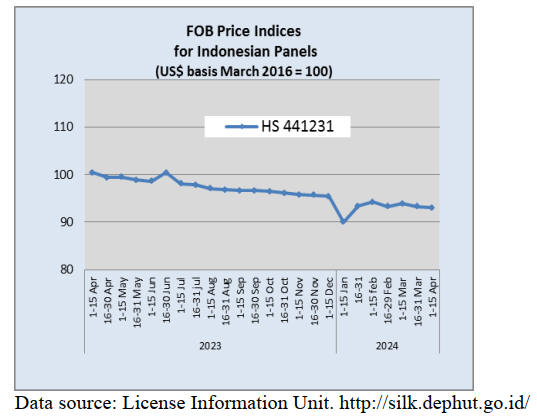
5.
MYANMAR
UN warns of deteriorating situation in Myanmar
The escalating conflict and heightened violence in
Myanmar since 2021 are profoundly affecting human
rights, fundamental freedoms and the basic needs of
millions of people according to U.N. officials.
Assistant Secretary-General for Political Affairs, Khaled
Khiari, informed the U.N. Security Council that civilian
casualties continue to rise amid reports of indiscriminate
bombing by Myanmar's armed forces and artillery shelling
by various parties. Thousands of young people have
sought refuge in jungles and mountains along remote
border areas fleeing military suppression and aligning with
opposition forces.
See:
https://press.un.org/en/2024/sc15652.doc.htm
and
https://reliefweb.int/report/myanmar/remarks-assistant-secretary-general-khaled-khiari-open-security-council-meeting-myanmar-new-york-4-april-2024
Myanmar delegation visits Vietnam
A delegation from Myanmar recently visited the Vietnam
Forest Certification Office (VFCO) to gain insights and
strategies regarding the development of the Vietnam
Forest Certification Scheme (VFCS).
The Myanmar delegation and the VFCO affirmed their
commitment to continued collaboration in promoting
sustainable forest management certification within their
respective countries, the region and globally. The
Myanmar delegation comprised senior management
personnel from the Forest Department and Myanma
Timber Enterprise. This visit was facilitated by the
Myanmar Forest Certification Committee (MFCC) under
the ITTO project ‘Strengthening SFM Standards and the
Timber Legality Framework of Myanmar.’
Taking about the visit, Barber Cho, Secretary of the
MFCC, said the visit aimed to facilitate engagement with
key stakeholders in Vietnam pivotal to successful timber
exports. These stakeholders include the Vietnam
Department of Forest, Vietnam Forest Certification Office,
smallholders of group-certified forests, intermediate and
small sawmills in Hanoi and leading furniture exporters in
Ho Chi Minh City.
Given the project's objective to establish a certified
plantation forest the MFCC orchestrated the visit to enable
the Myanmar delegation to observe how Vietnamese
entities collaborate for the advancement of forest
certification and timber legality to support the timber
industry and exports. Insights garnered from this visit will
be used in framing recommendations in the project report.
See -
https://vfcs.org.vn/en/news/welcoming-the-myanmar-delegation-and-sharing-experiences-in-developing-the-vietnam-forest-certification-scheme/
Businesses withdrawing
The domestic media has reported US energy giant
Chevron has completed the exit from the Yadana natural
gas field in Myanmar.
In related news the Malaysian telecommunications
conglomerate Axiata Group has announced the divestiture
of its entire holding in Edotco Myanmar.
See:
https://www.businesstimes.com.sg/international/asean/chevron-hands-myanmar-gas-field-stake-junta-thailand-s-pttep
and
https://www.businesstimes.com.sg/international/asean/malaysian-telco-axiata-sell-myanmar-telco-tower-business-us-150-million
Foreign trade decline exceeds 11%
Data released by the Ministry of Commerce indicated a
reduction of over 11% in international trade in 2023.
Trade through maritime routes and overland border
crossings amounted to US$28.8 billion in the 2023-2024
fiscal year compared to US$32.6 billion in 2022-2023.
International traders cite continuous fighting is shutting
down land routes and challenges in obtaining trade
licenses.
See -
https://myanmar-now.org/en/news/foreign-commerce-falls-by-more-than-11-percent/
6.
INDIA
India to become the
third-largest construction market
globally
The construction sector accounts for 9% of India’s GDP
and is the second-largest employer in the country and the
country is seeing a construction boom. Union Minister for
Housing and Urban Affairs, Hardeep Singh Puri, has
suggested that next year the country is set to become the
third-largest construction market globally after China and
the US.
It has been estimated that the industry could grow to
US$1.4 trillion by 2025. In the 2023 July to September
quarter construction expanded 13% year-on-year, marking
its best performance in the last five quarters. The
impressive growth has been attributed to higher and rising
incomes, a significant housing shortage in major cities,
population growth and robust government expenditure on
infrastructure development.
The construction industry in India comprises two main
segments, real estate and urban development. Within the
real estate segment there are residential, office, retail, hotel
and leisure projects. The urban development segment
encompasses sub-sectors, including water supply,
sanitation, urban transport, schools and healthcare
facilities.
In the 2024-2025 budget announcement, The Minister of
finance, Nirmala Sitharaman, announced an allocation of
Rs 11.11 lakh crore (US$134 billion) for infrastructure
development worth 3.4% of the GDP. This was up from
Rs 10 lakh crore in 2023-24.
Infrastructure development is also one of the leading
recipients of foreign direct investment (FDI) occupying
sixth place overall and has attracted over US$32 billion
since 2000. The Real Estate sector boasts of connections
with over 250 ancillary industries and provides
employment for more than 18% of the workforce.
In related news, the government has reported that GDP
expanded 8.4% in the October to December quarter thanks
to brisk manufacturing and construction. The government
also revised up its GDP growth forecast for the year
ending in March 2024 to 7.6%, from its January projection
of 7.3%.
The third-quarter GDP number was the highest in six
quarters and was the result of 12% rise in manufacturing
activity and a 10% expansion of the construction sector.
The previous two quarters' GDP growth rates were also
revised up to 8.2% for April-June, from 7.8%, and to 8.1%
for July-September, from 7.6%.
Domestic demand to slow during elections
The correspondent in India writes “the new financial year
has just started and markets are quite slow as our
parliamentary (Lok Sabha) elections are scheduled to start
19 April until 1 June (in all 7 phases).
About 970 million people in in India, a country of more
than 1.4 billion will go to the polls soon. Ballot counting
scheduled for 4 June, three days after voting ends. Among
those registered to vote are 18 million first-timers 18 or 19
years oldas well as 8.2 million people over 85.
The seven-phase general election runs from 19 April to 1
June with over 1 million polling stations and 15 million
employees conducting the nationwide polls.
Usually, during the pre and post election period, deamnd
tends to become quiet as big government projects slow.
Another reason is that the summer season has set in and it
is very strong in most parts of India”.
See:https://www.news18.com/india/india-third-largest-construction-market-2025-infra-boom-8788759.html
and
https://asia.nikkei.com/Economy/India-Q3-GDP-growth-surges-to-8.4-exceeding-expectations
Plywood Federation raises alert on raw material
availability
The Federation of Indian Plywood and Panel Industry
(FIPPI ) has requested consideration be given to
relaxing/liberalising the licensing/permit requirements for
transportation and processing of logs from agro-forestry
sources to ensure the panel industries have adequate and
competitively priced raw materials.
The FIPPI complains the government is yet to come with a
policy for the sustainable development of wood and panel
industry in the country. The FIPPI has been quoted as
saying the current licensing and transport permit system is
a handicap for industry.
The FIPPI recommends the establishment of national
council for wood and wood products under Ministry of
Commerce and Industry and that a separate legal
framework for ‘Growing Trees Outside Forests”
(Promotion and Facilitation) is needed. FIPPI also requests
a reduction in the import duty on large diameter round
logs to meet the requirement of sawmills, veneer mills and
furniture factories as the domestic industry is still
dependent on imported logs.
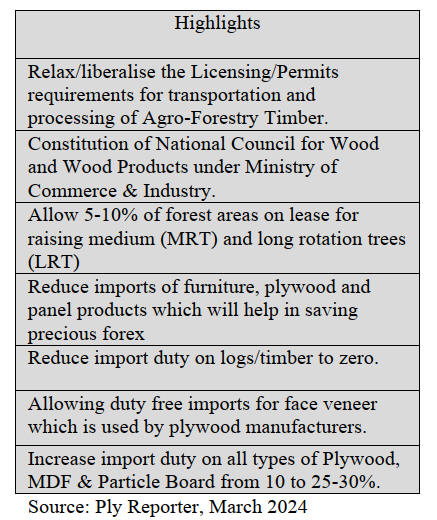
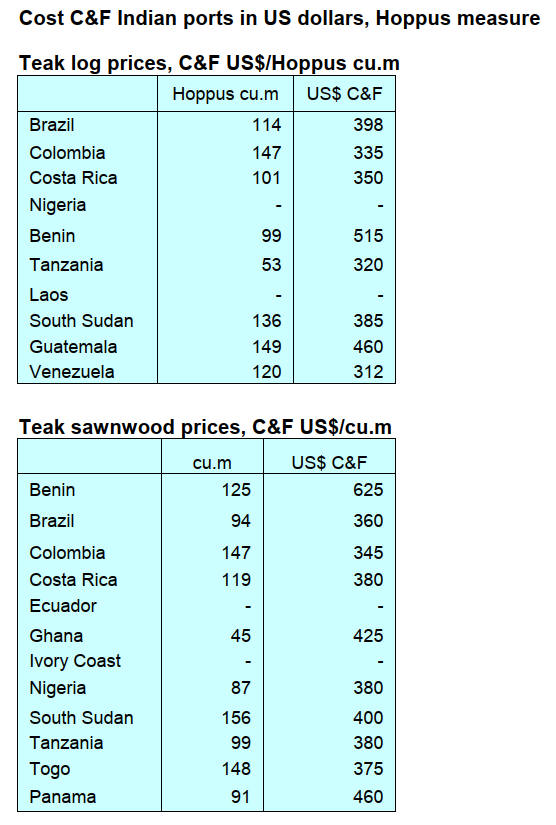
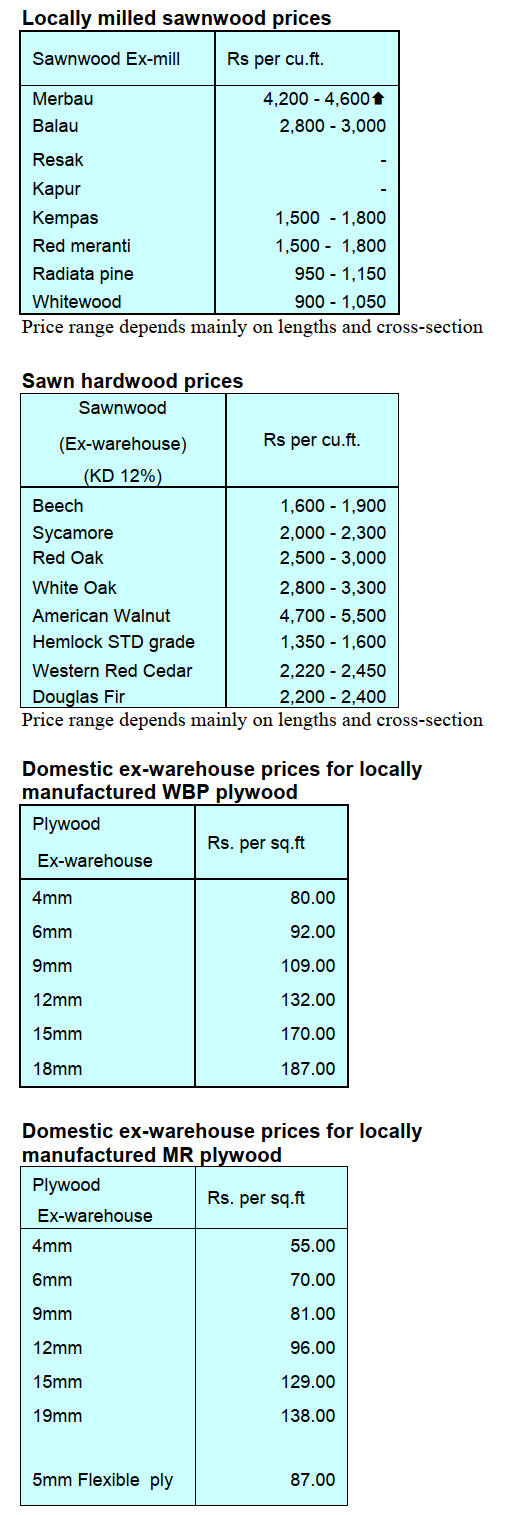
7.
VIETNAM
Wood and Wood Product (W&WP) trade highlights
According to Vietnam Customs Office, in March 2024
Vietnam’s W&WP exports were worth US$1.12 billion,
up 46% compared to February 2024 but down 2%
compared to March 2023. In particular, exports of wood
products contributed US$749 million, up 58% compared
to February 2024, but down 4% compared to March 2023.
Generally, over the first 3 months of 2024 W&WP exports
earned US$3.4 billion, up 19% over the same period in
2023. WP exports, in particular, accounted for US$2.3
billion, up 23% over the same period in 2023.
Vietnam’s W&WP imports in March 2024 stood at
US$190.0 million, up 55% compared to February 2024.
However, compared to March 2023 they were down 2%.
In the first 3 months of 2024 W&WP imports were
recorded at US$532 million, up 15% over the same period
in 2022.
Vietnam's imports of wood raw materials in March 2024
amounted to 446,200 cu.m, worth US$145.0 million, up
70% in volume and 71% in value compared to February
2024. Compared to March 2023 imports increased by 19%
in volume and 7% in value.
In the first 3 months of 2024 imports of wood raw
materials were estimated at 1.143 million cu.m, worth
US$373.7 million, up 23% in volume and 10% in value
over the same period in 2023.
Vietnam’s NTFP exports in March 2024 showed the
highest level over the past 2 years reaching US$85
million, up 80% compared to February 2024 and up 35%
over the same period in 2023. Generally, in the first 3
months of 2024 NTFP exports earned US$212.07 million,
up 28% over the same period in 2023.
W&WP exports to the US in March 2024 were valued at
US$555 million, up 50% compared to February 2024 but
down 8% compared to March 2023. In the first 3 months
of 2024, W&WP exports to the US earned about US$1.7
billion, up 26% over the same period in 2023.
Vietnam’s woodchip exports in March 2024 were recorded
at US$250 million, up 38 compared to February 2024 and
up 38 compared to March 2023. In the first 3 months of
2024 woodchip exports earned US$648 million, up 23%
over the same period in 2023.
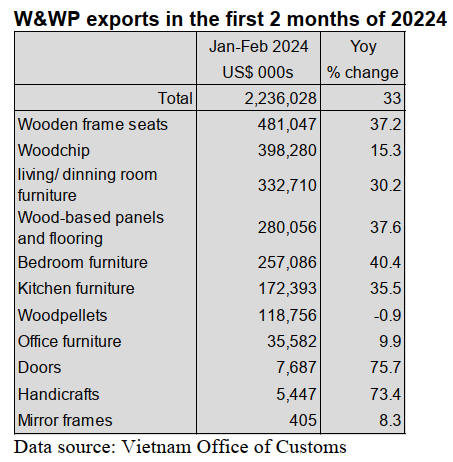
Rays of optimism emerging
In late 2023 the global furniture trade outlook seemed
quite gloomy. Yet, the Vietnamese wood industry has seen
certain rays of optimism. In the first 2 months of 2024 the
W&WP exports to the US, as the top export market,
earned over US$1.2 billion equivalent to 53% of total
exports.
China, as the next major market, consumed US$306.3
million, up 25% over the same period in 2023 while Japan
shared US$270 million, up 0.2% and EU reached US$106
million USD, up 36%.
Information from many W&WP manufacturers reveals
that many retailers have come back to Vietnam with orders
as furniture inventories in their home countries are low
and their economies are slowly recovering.
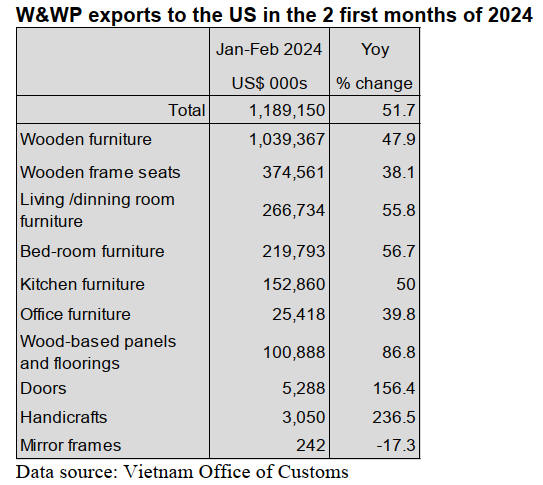
W&WP exports to the US in January 2024 increased
significantly, contributing a boost to exports over the first
quarter of 2024 to grow by double digits. In the structure
of W&WPs exported to the US, wooden furniture has been
dominating the trade with the value of US$1.04 billion, up
48% year-on-year, accounting for 87% of total exports to
the US.
Wooden seat frame is a major item and earned US$374.6
million, up 38% over the same period in 2023. This was
followed by living and dining room furniture, US$266.7
million, up 56%, bedroom furniture US$219.8 million, up
57%. In addition, wood-based flooring panels and wooden
door export grew.
Vietnam’s imports of wood raw materials rise
In March 2024 Vietnam has imported 446,200 cu.m of
wood raw materials in the form of logs and sawnwood
worth US$145.0 million, up 70% in volume and 71% in
value compared to February 2024. As compared to March
2023 imports surged by 19% in volume and 7% in value.
In the first 3 months of 2024 imports of wood raw
materials totaled 1.143 million cu.m, worth US$373.7
million, up 23% in volume and 10% in value over the
same period in 2023.
Log and sawnwood suppliers
In the first 2 months of 2024 imports from major suppliers
such as China, EU, Thailand, US, Chile, Laos and Brazil
increased year-on-year while a downturn occurred with
some other suppliers including Cambodia, New Zealand,
Congo and Malaysia.
Imports of wood raw materials from China accounted for
17% of total imports reaching 115,400 cu.m, worth
US$44.6 million, up 165% in volume and 963% in value
over the same period in 2023. From EU, imports increased
by 9% in volume and 12% in value over the same period
in 2023 reaching 89,800 cu.m, worth US$27.9 million,
accounting for 13% of total imports.
Imports of wood raw materials from Thailand increased by
67% in volume and 68% in value over the same period in
2023 reaching 79,500 cu.m, worth US$16.4 million,
accounting for 11% of total imports.
In addition, imports from other suppliers increased
compared to the same period in 2023 such as the US
where there was an increase of 33%; Chile plus 116%;
Laos plus 26%; Brazil plus 138%; Papua New Guinea plus
66%.
In contrast, imports from other shippers in the first 2
months of 2024 dropped compared to the same period in
2023 such as from Cameroon down by 492%; New
Zealand down 0.5%; Congo down 41% and Malaysia
down 16%.
In the first 2 months of 2024, the average imported price
of wood raw materials stood at US$328.3/cu.m, down
10% over the same period in 2023. In particular, the
imported price of wood raw materials from China dropped
by 26% over the same period in 2023 to US$386.7 per
cu.m, while prices from the US fell by 0.6%, to US$426.8
per cu.m and from Cameroon they dropped by 1%, to
US$438.4 per cu.m.
Order levels improved
Vietnam’s W&WP exports in the first 3 months of 2024
have shown positive signals after the gloomy past years.
With total exports of US$3.4 billion the export growth has
been calculated at 19% year-on-year. In the first quarter of
2024 Vietnam’s wood industry has revealed more positive
signals.
Orders have been arriving and some businesses report they
have already received orders through to the end of the
second and third quarters of this year. It has ben learned
that inventories in end markets have run low and
Vietnamese manufacturers and traders are about to
welcome back traditional customers.
The US, China, Japan and Korea remain as the 4 top
export markets accounting for about 85% of total exports
from Vietnam's wood industry. Starting from the
beginning of this year consumption in these markets has
shown signs of recovery and improvement. In addition,
non-traditional markets, such as India, Canada and many
countries of the Middle East are being developed.
With the recovery of targeted overseas markets and
Government policies to shift radially to legally sourced
raw materials taking into account the upcoming
enforcement of EUDR, imports of wood raw materials in
the coming months are forecasted to follow an upward
trend along with the increasing demand from processing
plants.
Plans for plantations of large sized trees
In the late 1980s, under land-tenure reforms the
Vietnamese Government started allocating land to farmers
previously used by state forest enterprises.
With the land allocated by the Government at average size
of 2–3 ha per household for long-term use Vietnamese
farmers have been inspired to engage in tree growing. The
cutting cycle in these small ‘plantations’ of mostly acacia
is too short (between 4–6 years) to produce mill sized logs
so most is sold to woodchip plants.
According to local experts, sustainable forest certification
over one million hectares of larger-sized timber forests is a
passport for Vietnam's wood processing industry to
increase exports. Moreover, achieving sustainable forest
certification for one million hectares of large-sized timber
forests is a move to reduce dependence on imported raw
materials.
According statistics from the Department of Forestry
under the Ministry of Agriculture and Rural Development,
the country's current total forest area is about 14.74
million hectares. Of the 14.74 million hectares planted
forests account for 31% while natural forests account for
69%.
In 2022, Vietnam earned US$15.67 billion from exporting
forest products and the country aims to earn US$18-20
billion from exporting forest products by 2025 andUS$23-
25 billion by 2030.
According to Mr. Vu Thanh Nam, Head of the Department
of Forestry's Forest Use Division the country currently has
about 4 million hectares of production forests providing
about 20 million cubic metres of wood planted mainly
with acacia, eucalyptus, cinnamon and pine. However,
forestry experts advised that Vietnam should switch to
investing in large-sized timber forests to further increase
export value.
Statistically, of the existing four million hectares of
production forests, the area of large timber plantations is
currently about 440,000 hectares of over 10-year-old trees
accounting for around 10% of the total. Currently, the
State has a policy to support forest planters with VND8
million per hectare and the Ministry of Agriculture and
Rural Development has submitted to Government
suggestions on a policy to encourage forest planters to
borrow capital to grow large sized trees.
The Ministry of Agriculture and Rural Development is
developing a project to plant timber forests for the period
2023-2030 and this includes mechanisms and policies on
cooperation and association with the aim to have 1 million
hectares of large-sized timber forests by the end of 2030.
Along with this localities will promote the planting of
large timber forests. According to Mr. Tran Lam Dong,
Deputy Director of the Vietnam Academy of Forest
Sciences, it is necessary to enhance cultivating trees in
areas with sustainable tree-planting certification to
produce raw materials for export manufacturing.
Vietnam has two types of forest certifications including
the national forest certification system (VFCS) of the
Office of Sustainable Forest Management Certification
and FSC forest management certification from the
International Forest Stewardship Council. As of
September 2023, Vietnam's total forest area that has
achieved both VFCS and FSC certifications is nearly
500,000 hectares, reaching more than 90% of the target set
for 2025.
See:
https://en.sggp.org.vn/vietnam-strives-to-have-1-million-hectares-of-large-wood-with-certifications-post106573.html
8. BRAZIL
Addressing improvements
to port operations
The Brazilian Association of Mechanically Processed
Timber Industry (ABIMCI), in partnership with the
Federation of Industries of Paraná (FIEP), recently
discussed the challenges of port operations, especially at
container terminals.
Around 200 representatives of companies that use the port
system, port authorities and export control agencies
attended the meeting which highlighted the need for
immediate improvements in export logistics and the need
for investments in port infrastructure to ensure efficiency
and competitiveness.
Logistics is a crucial factor in the performance of exports.
In addition to the need for immediate improvement in the
flow of containers through the ports, the meeting
determined it is also important to take a look at existing
port structures, expansions and new investments to be
offered by service providers. Processed wood products
represents approximately 40% of all shipments through
container terminals.
During the meeting several problems were discussed
including the lack of area for cargo handling,
unpredictability in shipments and tight deadlines for
releasing goods, all of which highlighed the importance of
joint action to optimise handling processes.
Short, medium and long-term solutions were discussed
including integration between export control agencies, an
increase in the number of employees, improvements to the
port area, infrastructure and road access and investment in
new dredging methods to deepen port access channels.
These discussions reflect the sector's commitment to
seeking solutions that promote the efficiency and
competitiveness of port operations in Brazil.
See:
https://abimci.com.br/industrias-e-autoridades-debatem-busca-de-solucoes-para-os-gargalos-do-sistema-portuario/
New forest management Standard to boost
international trade
A new Standard, ABNT PR 1020 Recommended Practice
- Management of Natural Tropical Forest, was officially
launched on 4 April 2024 adding value to sustainable
forest management and guaranteeing certification of the
origin of products by the Brazilian Association of
Technical Standards (ABNT).
This milestone will strengthen international trade
opportunities in forest-based products from the State of
Mato Grosso in the Amazon region through providing
consumers with more security and traceable and verified
sustainable products.
The initiative received support from the government and
industry leaders including representatives from the
Federation of Industries of Mato Grosso (FIEMT), the
Center of Timber Producing and Exporting Industries of
the State of Mato Grosso (CIPEM) and the National
Forum of Forest-Based Activities (FNBF).
CIPEM points out that the Standard will help boost trade
in forest products on the domestic market and
internationally. For FIEMT, the forest-based sector plays
an essential role in the economy and the preservation of
the environment and the new ABNT standard is an
important achievement in attesting to the origin and
sustainability of forest products.
The internationally recognised certification issued by
ABNT guarantees the traceability of wood from the forest
to the end consumer thus strengthening the reliability of
the product's origin.
Together with the Forest Products Commercialisation and
Transportation System (Sisflora 2.0) implemented by the
Mato Grosso State government this initiative means Mato
Grosso is the first State to have traceability throughout the
production chain.
These measures not only boost the state's economy but
also position Mato Grosso State at the forefront of
sustainable development thus opening new markets and
strengthening its commitment to environmental security.
See:
https://simenorte.com.br/sem-categoria/norma-que-valoriza-manejo-florestal-ira-fomentar-comercio-internacional-de-produtos-madeireiros-de-mato-grosso/
Brazilian furniture exports grow
Brazilian furniture exports experienced a remarkable 16%
increase in the first two months of this year compared to
the same period last year. Earnings totalled more than
US$105.4 million. This performance not only highlights a
significant recovery in February but also suggests a trend
of continued growth in foreign trade at the start of this
year, indicating a positive change after a period of
negative growth in the past 12 months.
Despite the challenges facing the sector in 2023 recent
data reveals a remarkable recovery and the adaptability of
the Brazilian furniture industries. This improvement can
be attributed to a number of strategies, including increased
international competitiveness, innovations in design and
sustainability and ongoing efforts to expand presence in
foreign markets.
According to ABIMOVEL, this growth may continue
throughout the year because the efforts of the Brazilian
Furniture Project are gaining importance, strengthening
the vital role of exports and the expansion of the Brazilian
furniture industry, promoting the internationalisation of
Brazilian brands and supporting participation in global
events.
See:
http://abimovel.com/exportacoes-brasileiras-de-moveis-e-colchoes-crescem-114-no-1o-bimestre-de-2024/
Timber sector mission to Sweden and Austria
Business executive and representatives from the timber
and civil construction sectors will take part in an
international technical mission to Sweden and Austria in
April 2024. The aim of the mission is to deepen
understanding and exchange experiences on developing
public policies for timber construction in Brazil as well as
improving knowledge about technology applied to the
civil construction sector.
Representatives from the Brazilian Association for
Mechanically Processed Timber (ABIMCI) will
accompanying the mission emphasising its commitment to
encouraging the use of wood in Brazilian construction. At
the same time ABIMCI has focused its efforts on
contributing to the development of wood construction in
Brazil.
It recently signed a partnership agreement with the
Federation of Industries of the State of Paraná (FIEP) to
establish a permanent agenda with four Working Groups
covering areas such as research, development, and
innovation; public policies; market, promotion and
dissemination and qualification and training of workforce.
This initiative aims to consolidate advances and
possibilities discussed over the years, strengthening the
country's potential to adopt wood-based construction
methods, especially in the wood frame and engineered
wood systems.
See:
https://abimci.com.br/setor-madeireiro-participa-de-missao-para-suecia-e-austria-com-foco-em-construcoes-de-madeira-engenheirada/
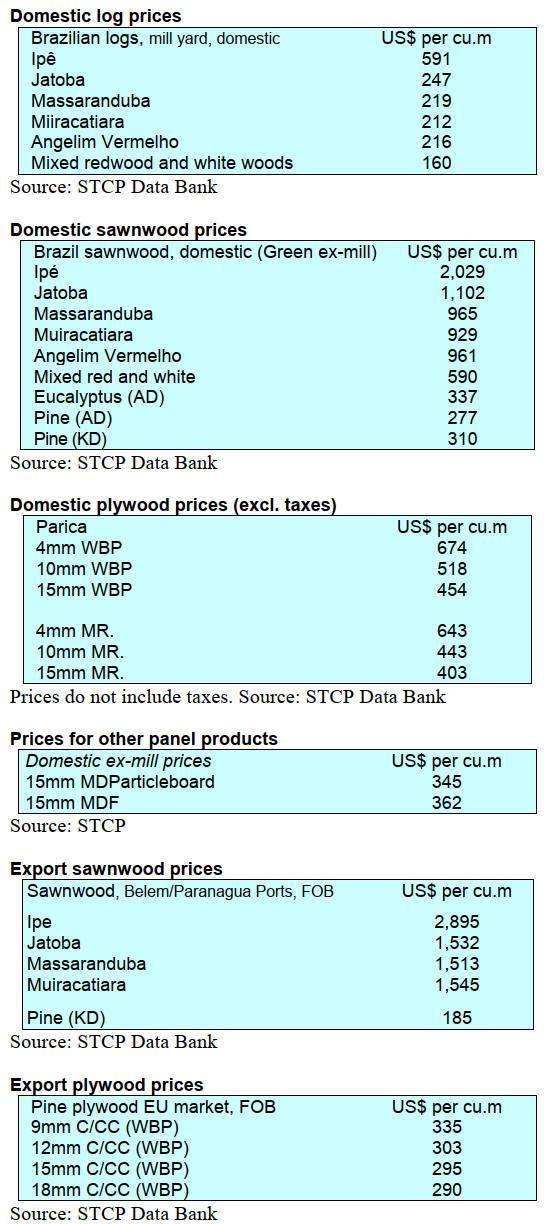

9. PERU
Imports of
chipboard higher in first two months of
2024
During the first two months of 2024 imports of
particleboard (PB/MDP) in Peru reached a value of US$32
million which represents an increase of almost 19%
compared to the same period in 2023 (US$27 million).
Ecuador remained the main supplier of PB/MDP to Peru in
the first two months of 2024 with shipments totalling
US$19 million, marking a significant 60% increase
compared to the same period in 2023. Ecuador's share of
total PB/MDP imports in Peru in the first two months of
2024 was 59% compared to 44% in 2023.
Brazil was the second largest shipper at US$5.2 million
with a 75% increase, the largest increase among the main
PB/MDP supplier countries in the first two months of
2024.
Spain fell to third place with US$4.1 million, a notable
decrease of 42% compared to the US$7.08 million
exported to Peru in the same period of 2023.
Chile was the fourth supplier country in the first two
months of 2024 with US$3.6 million, a decrease of 28%
compared to the same period in 2023.
Permit holders in Ucayali trained on OSINFOR
supervision processes
The Forestry and Wildlife Resources Supervision Agency
(OSINFOR) trained holders of forest permit titles in
Pucallpa on timber forest concessions and forestry
supervision processes and the need to comply with the
regulations.
The workshop was held using various teaching techniques
and the participants acquired practical knowledge about
the supervision process and forestry obligations.
See:
https://www.gob.pe/institucion/osinfor/noticias/928792-concesionarios-de-madera-en-ucayali-conocen-el-process-de-supervision-del-osinfor
‘Gestiona Forestal’ a digital platform for traceability
The National Forestry and Wildlife Service (SERFOR) has
launched a digital platform ‘Gestiona Forestal’ which will
provide for wood traceability in order to verify its legal
origin and achieve greater competitiveness in national and
international markets.
It is noted that sound forest management is essential to
reduce the risk of illegal activities and to comply with the
commitments required by the Peruvian State.
The Regional Forestry and Wildlife Manager of the
Regional Government of Ucayali said that, together with
other Amazonian authorities, they worked hand in hand
with SERFOR to launch this system.
He reported that 13 qualifying forest titles and 11 Primary
Transformation Centers in Ucayali province use the
Electronic Operations Books now integrated into
‘Gestiona Forestal’.
See:
https://www.gob.pe/institucion/serfor/noticias/928012-gestiona-forestal-permitara-la-acreditacion-legal-de-la-madera
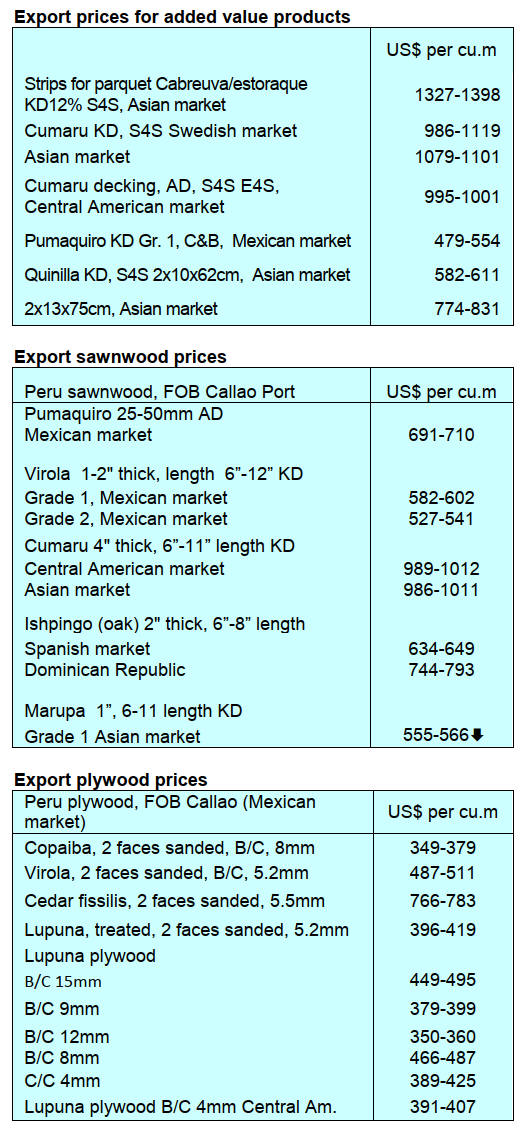
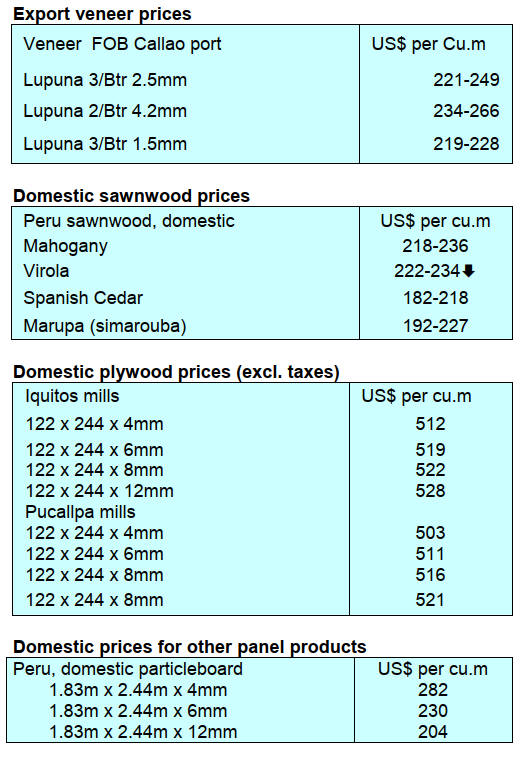
|